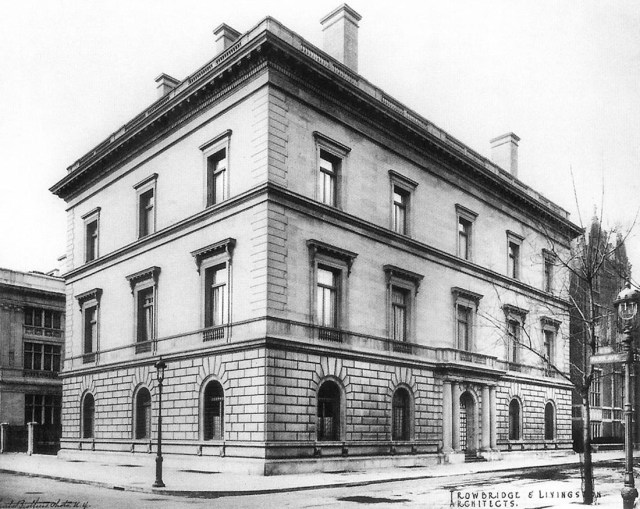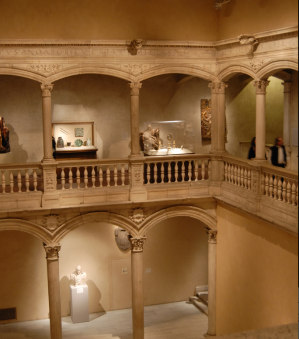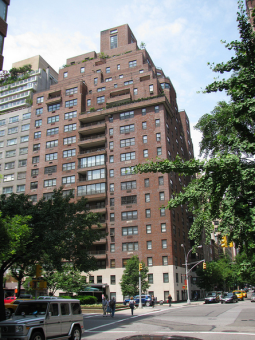One of the pet peeves of Michael Gross in his Rogues’ Gallery, a history of the Metropolitan Museum of Art, is how long it took its board’s stuffed shirts to accept modern art into its collection. Here is an amusing passage by which Gross looks down his nose at Met president George Blumenthal. Derision was accomplished by noting that Blumenthal, who disliked modern art, was not a stuffed shirt in regard to everything.
Gross quotes a letter from New York City parks commissioner Robert Moses (yes, him; he was on the Met board as well) to Thomas Hoving, the Met’s executive director in a later era, reminiscing about visiting Blumenthal:
I went to see George once at his Gothic mansion on Park Avenue. … A lovely little French maid in a brief, trim, black uniform and a little white apron was sitting on George’s lap. She jumped up and discreetly melted away. Said George, “You caught me off guard.” George didn’t like me among other things because … I paid his Museum bills. “No, George,” said I, “you remind me of Samuel Johnson, the great lexicographer. In a similar contretemps his indefatigable biographer Boswell said, ‘Dr. Johnson, I am surprised.’ Said the old curmudgeon, never at a loss for the right word, ‘Boswell, you’re astonished. I’m surprised.'”
I find myself sympathizing with Blumenthal – not for having a maid on his lap (I am appalled!!!) but for his reluctance to bring modern art into the Met. Not that I disagree that modern art has a place there; even though there were by the early ’40s the Museum of Modern Art (MoMA) and the Whitney for modern art. But modern did and does deserve a place in the city’s top and presumably most broadly representative art museum. Still, as I read through Rogues’ Gallery, I acknowledge that I, too, would have been dragging my feet, if not my knuckles.
But you know that. This post really is dedicated to Dr. Johnson and his marvelous ability to make the timely distinction between surprised and astonished for Boswell. (Plus, I like the idea of the curmudgeonly Johnson with a trollop on his lap.)
Blumenthal’s Gothic mansion, as referred to by Moses, was designed by Trowbridge & Livingston, completed in 1910, demolished in 1943 after Blumenthal’s death, and replaced by the apartment building, 710 Park Ave, completed in 1948. The Blumenthal mansion’s interior patio was scavenged from a Spanish castle and donated, stone by stone, to the Met, where it remains on display.
(A commenter notes that the mansion is not Gothic but Renaissance Revival.)






This is a terrific story from what looks like a wonderful book which I, admittedly have not read. It isn’t clear, therefore what time period Gross is bemoaning, but your comment suggests it was sometime after the early 1940s when, you point out, the city already had MOMA and the Whitney. As you probably know, the Whitney was founded expressly because the Met turned down Gertude Vanderbilt Whitney’s 1929 offer to donate her collection of 700 works of modern art. Perhaps it is this event that Gross is referring to? The story goers that Mrs. Whitney’s offer was refused before she had a chance to clarify her intent to make a substantial contribution toward a facility to house the collection.
LikeLike
Bill, the Met’s reluctance to add modern works, or works by living artists, to its collection spanned decades, going well back into the 19th century. I’m not sure he’s referring to a particular event – but you are right about the Whitney’s origins.
LikeLike
I’m surprised and astonished that you call that building Gothic! And you pretend to be knowledgeable about architecture history? The photograph is a Classic Revival building, heavily influenced by Florentine Renaissance pallazzi, such as the Pallazzo Medici Riccardi.
LikeLike
No, Peter, you are astonished and I am surprised. But you are right. Though it was the extraordinarily erudite genius Robert Moses who made the mistake, I repeated it. I have made a correction at the end of the post.
LikeLike